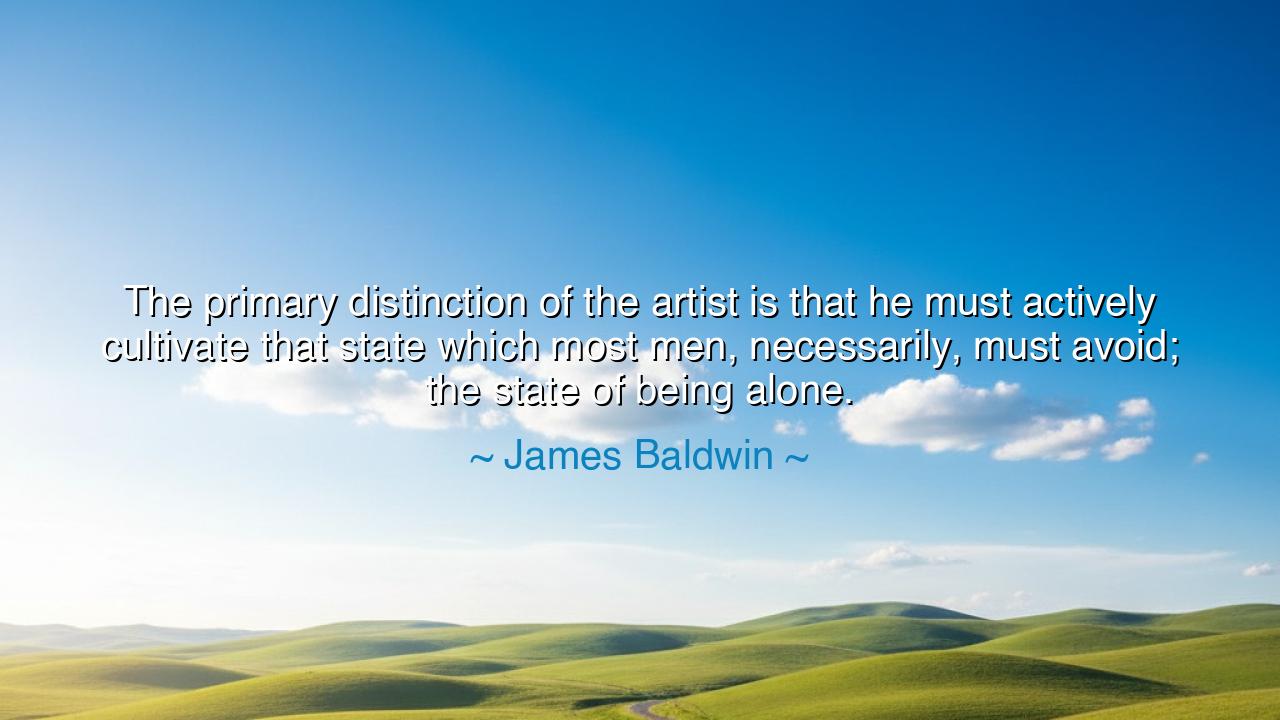
The primary distinction of the artist is that he must actively
The primary distinction of the artist is that he must actively cultivate that state which most men, necessarily, must avoid; the state of being alone.






“The primary distinction of the artist is that he must actively cultivate that state which most men, necessarily, must avoid; the state of being alone.” — thus spoke James Baldwin, the fierce prophet of the soul, the seer of truth in the heart of struggle. His words pierce the surface of comfort and strike the eternal chord of creation. In this sentence lies not merely advice to the artist, but a revelation of what it means to face oneself — to dwell in the silence where the world’s noise falls away, and where truth, raw and unguarded, begins to speak. For Baldwin knew that to create is to confront, and that the artist must dare to walk where others cannot bear to linger — into the desert of solitude.
The origin of this quote lies in Baldwin’s own life, one steeped in both exile and revelation. Born into the hardness of Harlem, he carried within him the fire of a preacher and the insight of a poet. He fled to Paris not to escape the world, but to see it clearly — to escape the clamor of a country that would not yet listen, so that he could learn the voice of his own heart. In that distance, in that aloneness, Baldwin discovered what countless artists before him had learned: that solitude is not emptiness, but a sacred chamber in which the self awakens. The artist, he said, must cultivate this state — not fall into it by accident, but choose it as one chooses truth, knowing it will wound before it heals.
For most men, being alone is a condition to be avoided, for in solitude, one must face the nakedness of one’s own mind. The crowd, the routine, the noise — these are the shields that guard the spirit from its own reflection. But the artist cannot afford such protection. He must sit in the stillness where the echoes of his fears, his desires, and his memories rise like ghosts. It is there, in that uneasy silence, that creation begins. From that confrontation, art is born — not from comfort, but from courage. The artist must walk willingly into that silence and dwell there long enough to hear the rhythm of truth that lies beneath the noise of the world.
Consider Vincent van Gogh, the man of color and agony. He lived a life of staggering solitude, misunderstood and forsaken. Yet it was in that very isolation — when the world’s warmth was denied him — that he painted suns that never set, fields that still blaze with divine light. In his loneliness, he reached beyond himself and found the eternal pulse of humanity. Van Gogh’s solitude was not madness alone; it was communion with eternity. He lived Baldwin’s wisdom without knowing it: that the artist must step apart not because he despises men, but because he seeks to love them through the language of truth.
The state of being alone, Baldwin tells us, is not a punishment but a discipline. It is a crucible where illusion burns away, where the artist learns to see not as society teaches, but as life reveals. From this solitude, the artist returns to the world bearing gifts — visions, stories, songs — that restore to others what they have lost in the noise of their days. But the cost of this gift is great. The artist must live with the ache of distance, with the knowledge that to understand the world too deeply is to stand slightly apart from it. Yet that is his sacred duty: to speak for those who cannot hear themselves.
This truth extends beyond the artist’s craft. For each soul, there comes a time when the world’s clamor must be set aside — when one must enter the quiet sanctuary of solitude to discover who they truly are. We too must learn to cultivate, not flee, our aloneness. In that space, we may come to know our deepest fears and highest callings. The mind that dares to be silent finds strength unknown to the one forever surrounded by noise. Thus, Baldwin’s words are not only for painters and poets, but for all who seek authenticity: learn to be alone, for it is there that truth reveals its face.
The lesson, then, is clear and eternal: solitude is not exile, but initiation. To withdraw from the world is not to abandon it, but to prepare oneself to serve it more deeply. The artist — and indeed, every awakened soul — must go into the wilderness of silence, not to escape humanity, but to return bearing light. So let us follow Baldwin’s wisdom: let us not fear the loneliness that life sometimes brings, but shape it, tend it, cultivate it — as a gardener tends to a rare flower. For in that stillness, we discover not only our art, but our essence, and through that essence, we come to know the world anew.
Thus remember, as Baldwin did: the artist must be alone — not as a rejection of life, but as its highest embrace. For only in solitude can the heart learn to listen, and only in listening can the soul begin to sing.






AAdministratorAdministrator
Welcome, honored guests. Please leave a comment, we will respond soon